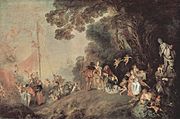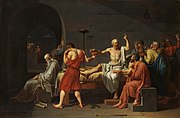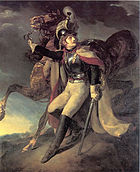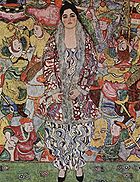Painting: Baroque and Rococo

Las Meninas by Diego Velasquez (1656).

The Judgment of Paris Ruben
From 1600 and throughout the seventeenth century, has developed a new style of painting, Baroque painting. Among the greatest Baroque painters must include Caravaggio, Rembrandt, Rubens, Velazquez, Poussin, and Vermeer. Caravaggio is an heir of the humanist painting of the High Renaissance. His realistic human characters shocked his contemporaries and opened a new chapter in the history of painting. Baroque painting often dramatizes scenes using light effects as illustrated by the paintings of Rembrandt, Vermeer, the Le Nain brothers or Georges de La Tour.

Pilgrimage to Cythera by Antoine Watteau
In the eighteenth century, the style Rococo emerged as a derivative of baroque painting, more decadent, lighter, often frivolous and erotic. The French masters Watteau, Boucher and Fragonard, are representative of this style, as Giovanni Battista Tiepolo and Thomas Gainsborough. Jean Simeon Chardin is in turn considered the best French painter of the eighteenth century.
Neoclassicism, Romanticism, Impressionism

The Death of Socrates by David

Madame Moitessier of Dominique Ingres (1856)
After the decadence of style Rococo emerged the neoclassicism of the late eighteenth century with artists such as Jacques-Louis David and his heir Dominique Ingres. The works of Ingres already contain sensuality, but not the spontaneity that would characterize Romanticism. This movement has focused on the representation of landscapes, nature, human figures and overall supremacy of the normal order of the human will. This conception of painting is part of the philosophy pantheistic (see Spinoza and Hegel) as opposed to the ideals of the Enlightenment by a more tragic or pessimistic over the fate of mankind. The idea that human beings are not above the forces of nature is at odds with the ideals of ancient Greece and the Renaissance, where mankind was above all things and was master of its destiny. These are the ideals that brought the romantic artists to depict the sublime, ruined churches, shipwrecks, massacres and madness.

Trooper injured leaving the fire of Theodore Gericault (1814)
The romantic painters have made landscape painting a large genus when it was previously considered as minor genre or as a decorative background. Among the major painters of this period were found Eugène Delacroix, Théodore Géricault, JMW Turner, Caspar David Friedrich and John Constable. The last pictures of Francisco de Goya show the interest of Romanticism to the irrational, while the work of Arnold Böcklin evokes the mystery. In the United States, the romantic landscape painting became known through the Hudson River School with painters such as Thomas Cole, Frederic Edwin Church, Albert Bierstadt and Sanford Robinson Gifford.

The Night Café, Place Lamartine, Arles of Van Gogh (in 1888)
The main painter of the Barbizon school, Camille Corot paintings realized sometimes romantic and sometimes imbued with a realism which announced the Impressionists. One of the major painters marking the turn to realism in the mid-nineteenth century was Gustave Courbet. In the last third of a century, the Impressionist painters like Edouard Manet, Claude Monet, Pierre-Auguste Renoir, Camille Pissarro, Alfred Sisley, Edgar Degas and post-impressionists such as Vincent Van Gogh, Paul Gauguin, Georges Seurat and Paul Cézanne, brought the painting to the gates of modernism.
Modern and Contemporary Painting
The legacy of post-impressionism, with painters like Van Gogh, Cezanne, Gauguin and Seurat has played a key role in the development of the modern art. In the early twentieth century, Henri Matisse and other young artists revolutionized the art world in Paris with paint "wild" colorful and expressive as critics called Fauvism. Pablo Picasso made his first painting Cubist based an idea of Cezanne that any representation of nature can be reduced to three solids: a cube, a sphere and a cone.
Pioneers
The early twentieth century was marked by the development of Fauvism with artists such as Henri Matisse, Georges Braque, André Derain, Raoul Dufy and Maurice de Vlaminck, which have deeply shaken the artistic milieu of the time.
With Les Demoiselles d'Avignon in 1907, Pablo Picasso creates a style of painting new and radical in representing crudely and so primary a brothel scene with five prostitutes, African tribal masks and containing its own inventions Cubist. The analytic cubism, which was jointly developed by Pablo Picasso and Georges Braque from 1908 to 1912, is the first clear manifestation of cubism. He was succeeded by Synthetic Cubism with Braque, Picasso, Fernand Léger, Juan Gris, Albert Gleizes, Marcel Duchamp and countless other artists in the 1920s. Synthetic cubism is characterized by the introduction into the paint in different textures, surfaces, elements of collage, pasted paper and a variety of topics merged.

Guitar, book and newspaper Juan Gris (1919)
The 1910s until the First World War, after the heyday of cubism, several movements emerged in Paris. In July 1911, Giorgio de Chirico came to Paris where he joined his brother Andrea (the poet and painter known by the name of Alberto Savinio) which enabled him to meet Pierre Laprade a member of the jury at the Salon d'Automne where He outlined three of his works: Enigma of an autumn evening (1910), Enigma of the Oracle (1910) and a self-portrait. In 1913 he exhibited his work at the Salon des Independents, where he was noticed by Pablo Picasso and Guillaume Apollinaire. His paintings are mysterious regarded as the beginning of Surrealism.
Moscow I Wassily Kandinsky (1916)
During the first two decades of the twentieth century, apart from cubism, several movements emerged Important:
- The Futurist (Giacomo Balla)
- the abstract art (Wassily Kandinsky, The Blue Rider)
- the Bauhaus (Kandinsky, Paul Klee)
- the Orphism (Robert Delaunay, Frantisek Kupka)
- the Synchromy (Morgan Russell)
- the De Stijl (Piet Mondrian)
- the supremacism (Kasimir Malevich)
- the constructivism (Vladimir Tatlin)
- the Dada (Marcel Duchamp, Francis Picabia, Jean Arp)
- the surrealism (Giorgio de Chirico, André Breton, Joan Miro, Rene Magritte, Salvador Dalí, Max Ernst)
Modern painting influenced all the visual arts, the architecture and design in modern film by avant-garde, from the theater and modern dance. It has also become a laboratory for experimental forms of visual expression such as photography, the calligram the fashion or advertising. Painting Expressionism of van Gogh painting has influenced the twentieth century, as reflected in painting tawny Die Brücke (a group led by German painter Ernst Ludwig Kirchner) or at d 'Edvard Munch, Egon Schiele, Marc Chagall, Amedeo Modigliani, Chaim Soutine ...
Wassily Kandinsky, a Russian painter, printer and art theorist, one of the most famous artists of the twentieth century, is generally designated as the first important painter of the abstract art modern. As a modernist, in search of new modes of visual expression and spiritual, he theorized painting as did the occultists and Theosophists. Kandinsky has developed many of his theories about abstract art in his book about spirituality in art. Robert Delaunay was a French artist associated with the Orphism whose contributions to abstract art is reflected by a bold use of color and a willingness to experience the depth and tone. In 1911, at the invitation of Kandinsky, Delaunay and his wife the artist Sonia Delaunay, joined The Blue Rider (Der Blaue Reiter), a group of abstract artists from Munich.
Among the other pioneers of abstract painting have included the Czech painter, František Kupka and movement Synchromy near the Orphism, founded in 1912 by the American artist Stanton MacDonald-Wright and Morgan Russell.
Between the wars

In vacancy Kasimir Malevich (1927)

Portrait of Friederike Maria Beer from Gustav Klimt (1916)
The painting of Piet Mondrian was intimately linked to its spiritual and philosophical studies. In 1908, he became interested in movement Theosophical launched by Helena Petrovna Blavatsky in the late nineteenth century. She believed it was possible to attain a knowledge of nature more profound than that obtained by empirical means. Much of the work of Mondrian was inspired by research of this spiritual knowledge. The Russian painter Kasimir Malevich is another pioneer of the abstract art that, after the Russian Revolution of 1917 and after the oppressive regime of Stalinist in 1924, returned to figurative painting. Others include the painter Swiss Paul Klee, whose work on color has made him a pioneer of abstract painting of the Bauhaus.
In the United States of the inter-war painters tended to go to Europe to help them gain some recognition as was the case of Marsden Hartley, Patrick Henry Bruce and Stuart Davis who have made a reputation outside their country.
The expressionism and symbolism are movements that include several styles of painting of the twentieth century and which dominated much of the art avant-garde in Western Europe, Eastern and Northern. The expressionism of the inter-war period was mainly prevalent in France, in Germany, in Norway, in Russia, in Belgium and Austria. Expressionist artists are related to both Surrealism and Symbolism. The Fauvism, the Die Brücke and Der Blaue Reiter are three of the best known groups of Expressionist and Symbolist painters. Among the most influential artists of this movement there are Marc Chagall, Gustav Klimt, Egon Schiele, Edvard Munch, Emil Nolde, Chaim Soutine, Georges Gimel, James Ensor, Oskar Kokoschka, Ernst Ludwig Kirchner, Max Beckmann, Franz Marc, Otto Dix , Käthe Kollwitz, Georges Rouault, Amedeo Modigliani ...
In the 1930s and the Great Depression, the surrealism, the cubism late, the Bauhaus, the De Stijl, the Dada painters and colorists like Henri Matisse and Pierre Bonnard were characteristic of the European art scene while in America the movement social realism dominated the art world. Some artists have emerged from this new art scene as Ben Shahn, Thomas Hart Benton, Grant Wood, George Tooker, John Steuart Curry, Reginald Marsh and many others. In Latin America the movement of the mural with Diego Rivera, David Alfaro Siqueiros, Jose Clemente Orozco, Pedro Nel Gómez and the paintings of Frida Kahlo is a renaissance of art in this region, with the use of color and expression political messages.
On the eve of the Second World War, many of the surrealist artists were influenced by the radical political left, including Pablo Picasso with his famous painting Guernica. This work denounces the horrors of the bombing of Guernica on 26 April 1937, during the Spanish Civil War, by the Condor Legion of the Luftwaffe German.
After war
The second half of the twentieth century was for the art world, and painting in particular, a period of proliferation of artistic movements, with the birth of a great variety of movements in painting.
